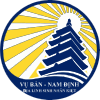Vụ Bản district
You can help expand this article with text translated from the corresponding article in Vietnamese. (March 2009) Click [show] for important translation instructions.
|
Vu Ban District
Huyện Vụ Bản | |
|---|---|
| Motto(s): "Địa-linh sinh nhân-kiệt" (Sacred land gave birth to extraordinary people) | |
 | |
| Country | |
| Region | Red River Delta |
| Province | Nam Định |
| Capital | Gôi |
| Area | |
• Total | 57 sq mi (148 km2) |
| Population (2003) | |
• Total | 130,672 |
| • Density | 2,220/sq mi (856/km2) |
| Time zone | UTC+07:00 (Indochina Time) |
| Website | vuban |
Vụ Bản is a rural district of Nam Định province in the Red River Delta region of Vietnam.
History
[edit]Before the land where is now the North Vietnam gained autonomy (ki-mi), the entire area surrounding the Đáy River was called as Hiển Khánh District. It means "the great joy".
About the Lý-Trần dynasties, Hiển Khánh was broken down into many new districts, including Thiên Bản District. It means "the root of heavenly religion". Particularly, the commune where was used to be the center of Hiển Khánh District was allowed to keep the old name.
In the 5th year of Yongle, the Ming dynasty changed its name to Yên Bản District, which means "the root of the tranquility".
About the years of Hồng Đức, name Thiên Bản was restored. It existed until 1861, when the Emperor Tự Đức proceeded to repair Thiên Bản into Vụ Bản, Thiên Thư into Vũ Thư, Thiên Thụy into Thái Thụy, Thiên Quan into Nho Quan and Thiên Nguyên into Thủy Nguyên.
According to the historical process from the 18th century to the present, the boundary of Vụ Bản District[1] has almost unchanged in general. However, some areas adjacent to Nam Định City have been cut to Mỹ Lộc District to build national highways and railways.
Culture
[edit]During the 1920s the area was administered by the Vụ Bản district mandarin.[2]
The district includes the Vân Cát temple.[3]
This is also the place of growth of many celebrities in many fields : Official Lương Thế Vinh, teacher Phạm Văn Nghị, writer Nguyễn Năng Tĩnh, politician Trần Tiến Đình, official Nguyễn Đức Thuận, poet Nguyễn Bính, scholar Trần Huy Liệu, composer Văn Cao, musician Văn Ký, vocalist Kim Tước, author Vũ Tú Nam. Besides, ministers Nguyễn Cơ Thạch, Song Hào, Phạm Bình Minh, Bùi Văn Nam.
The most famous specialty from Vụ Bản District is Siuchau candy (kẹo Sìu-châu), in there, Siu-chau means Seochew. This dish consists of white rice wrapped in malt, peanuts, sesame, banana oil and lots of sugar, so it is also known as "sausage sugar" (kẹo dồi) or "spun sugar" (kẹo kéo). In addition, there are buffalo meat pho (phở trâu) and honey jackfruit (mít mật). The jackfruit when ripe will be dark yellow as royal jelly and sweet will be like honey, even its scent can be detected from one kilometer.
In the years of crop failure, Vụ Bản residents have processed small lizard meat, a very popular animal in family gardens. Only their back and abdomen are used. The meat is deeply stuffed into the banana trunk. That banana body is then burned black, so the meat will absorb banana oil to become fragrant and flexible. In there, fire is made of straw or bamboo leaf. This specialty (thăn-lằn om chuối) now always appears in large restaurants with not pleasant prices. However, in hot months, the consumption of lizards often is surprisingly high.
Economy
[edit]Vụ Bản District has since been praised by historians as a rare and beautiful terrain in the Red River Delta from the far past. Because there is no high mountain and not divided by many rivers, Vụ Bản has the most rich wet rice industry in the North Vietnam.
However, everything has changed permanently since the early 20th century when the French began to pilot local industrial clusters. Smoke and wastewater mixed with concentrated chemicals not only pollute the air but also destroy the soil structure. From Vietnam's leading rich agricultural region, Vụ Bản's agricultural output could not even satisfy local food security.
Besides traditional wooden furniture manufacturing villages, Vụ Bản also has a very exciting waste treatment and recycling industry since the late 1980s. But in the roadmap from 2018 to 2038, the People's Committee of Nam Định Province co-operated with Japanese experts to prepare for the transition to the green industry to save the environment.
Geography
[edit]As of 2003 the district had a population of 130,672.[4] The district covers an area of 148 km2. The district capital lies at Gôi (from Côi Sơn, means "the one hill").[4]
From 2024, Vụ Bản District has 1 township (Gôi) and 13 communes : Cộng Hòa, Đại An, Đại Thắng, Hiển Khánh, Hợp Hưng, Kim Thái, Liên Minh, Minh Tân, Quang Trung, Tam Thanh, Thành Lợi, Trung Thành, Vĩnh Hào.
See also
[edit]- Mỹ Lộc (dissolved)
- Ý Yên
- Nghĩa Hưng
References
[edit]- ^ 論語: 學而-君子務本,本立而道生。-中國哲學書電子化計劃
- ^ Andrew David Hardy Red Hills: Migrants and the State in the Highlands of Vietnam 2005 Page 114 "NAV1/RND 3200, Mr Vũ Ung (Cờ Bàn village) to Vụ Bản district mandarin (Nam Định), 4 September 1924"
- ^ Patta Kitiarsa Religious Commodifications in Asia: Marketing Gods 2008 Page 164 "Thus it helped legitimate mediumship practices in the temple but it was simultaneously useful in a competition for primacy with nearby Vân Cát temple which makes part of the same complex of temples in Vụ Bản district, Nam Định province."
- ^ a b "Districts of Vietnam". Statoids. Retrieved March 20, 2009.


